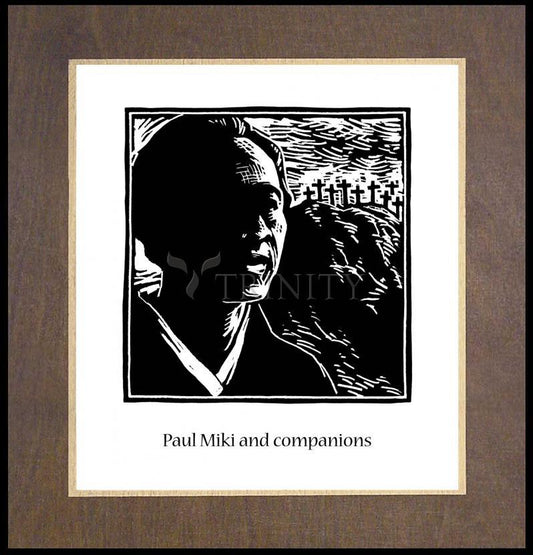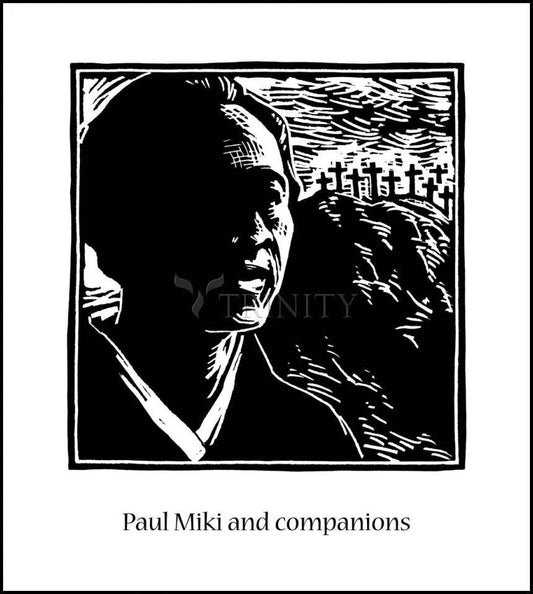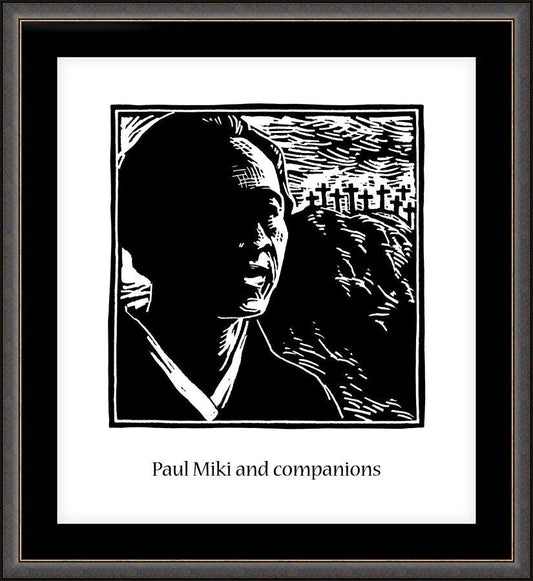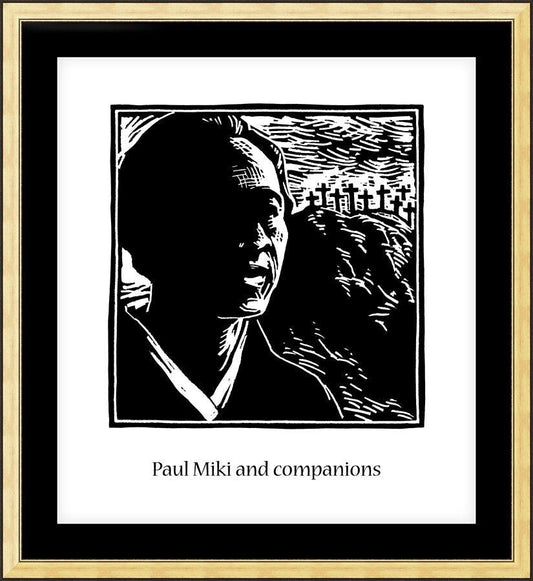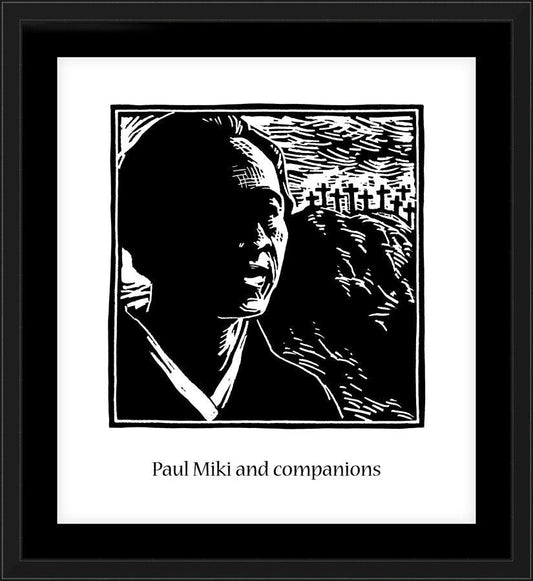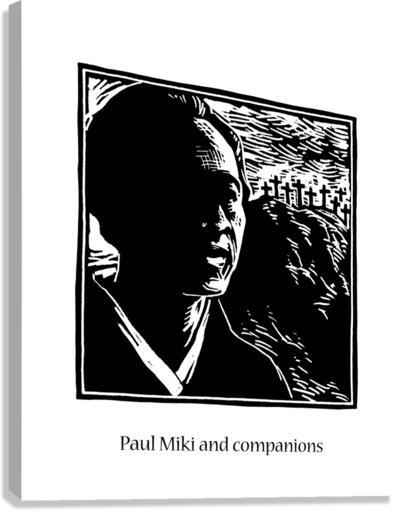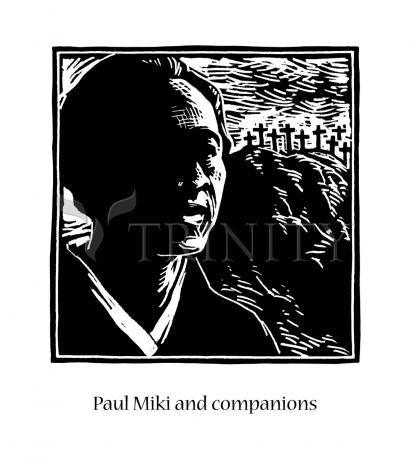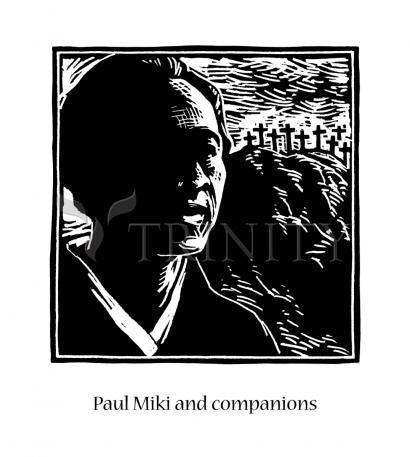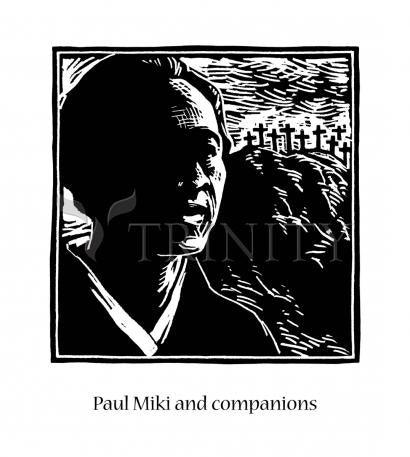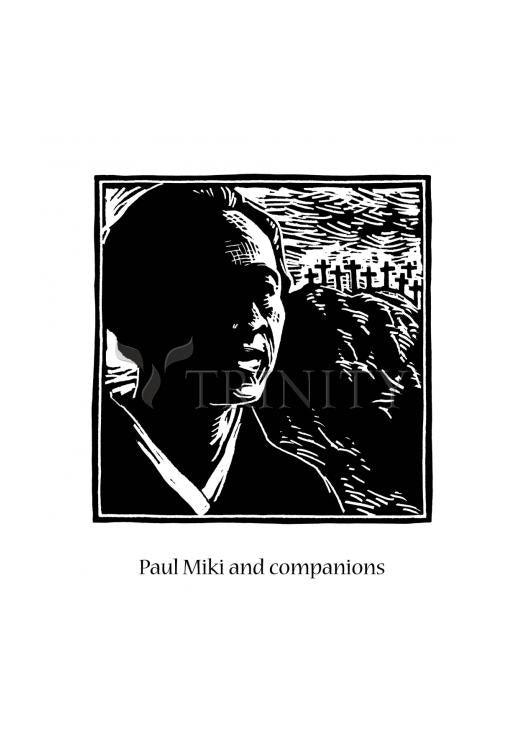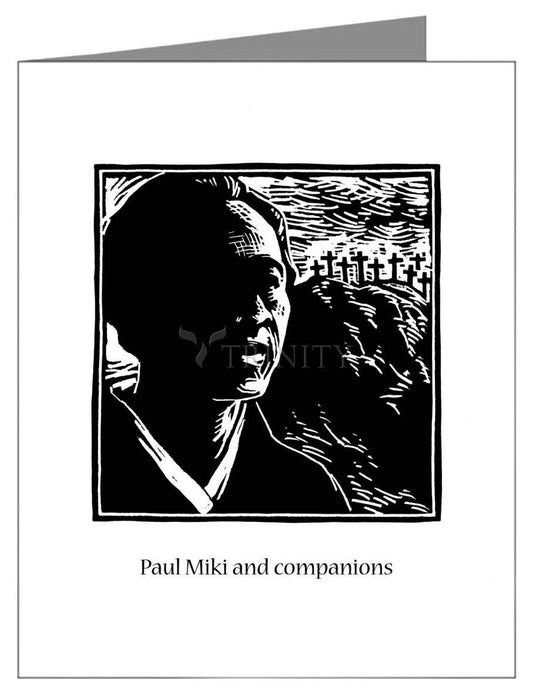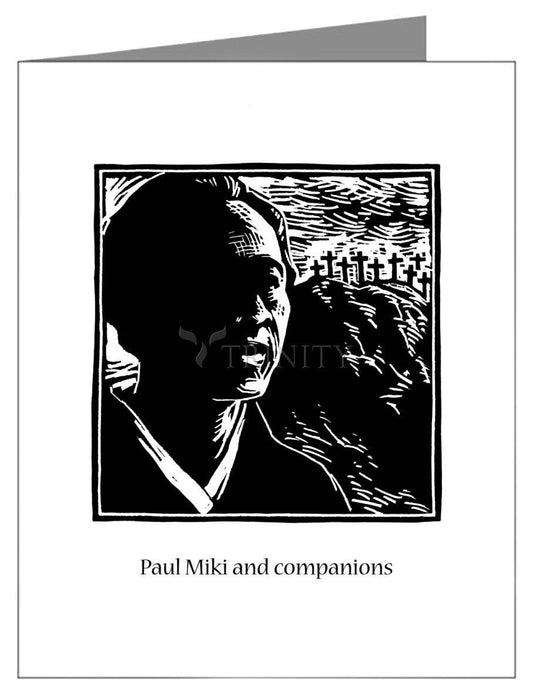Paul Miki saw sparkling Nagasaki harbor coming into view. The 600-mile journey from the Japanese capital of Kyoto through the cold and snow was nearly over. It had taken almost one month. Now the crown of martyrdom would soon be his.
Along the road, villagers jeered him and the twenty-three others who had been sentenced to die for their Christian beliefs. "Fools," they shouted, "Renounce your faith." Miki, who loved to preach, urged the people to believe in Jesus, the Savior who died for their sins so that they might live! Not all were insulting the prisoners, however. Fellow believers along the way blessed them, encouraged them, and prayed for them, giving them the strength and courage to continue on their journey.
Miki thought how odd it was that he was to die so soon before his ordination as a priest. Now thirty-three years old, he had been a Jesuit brother for eleven joyful years, studying and internalizing the mysteries of the faith. Recognized as an eloquent speaker, his fervent discourses had led to many conversions. Yet he was never to celebrate Mass, never to raise the consecrated host in his own hands. Perhaps in heaven he would have that privilege.
His thoughts on the journey often turned to his family. Miki had been born and raised in the Tsunokuni district near Kyoto in comfortable surroundings, the son of a brave soldier, Miki Handayu. A fellow Jesuit, Francis Xavier, had come to Japan in 1549, and his message of a loving triune God had pierced the souls of many Japanese. In 1568, when Paul was four years old, his parents converted to Christianity. Now there were hundreds of thousands of Christians in Japan, from poor peasants to feudal lords. Miki thought about how lovingly his parents had nurtured his faith. Educated in Jesuit schools, Miki never doubted his vocation.
The seeds planted by Xavier flourished, but only when it suited the reigning Japanese ruler. The military leader Oda Nobunaga allowed the missionaries to preach because he wanted to challenge the power of the Buddhist monks and he was interested in foreign trade. When Nobunaga died in 1582, one of his generals, Toyotomi Hideyoshi, seized power. At first, Hideyoshi tolerated Christianity.
Yet Christianity was a religion of foreigners, very different from Buddhism or the native Shintoism, which enshrined numerous minor gods. Japan feared conquest by the West. What if these foreign missionaries came not to bring their God but their soldiers? When Christianity began to claim thousands of converts, Hideyoshi became nervous. In 1587, he issued an edict banning all the Jesuit missionaries. The edict was never fully enforced, however, and Miki and his missionary friends continued for a number of years to evangelize unobtrusively.
Then, in the fall of 1596, a Spanish ship, the San Felipe, en route to Mexico from Manila, crashed into the coast of Japan. While Japanese officials confiscated the vessel's cargo, an arrogant remark by the ship's captain was interpreted to mean that missionaries intended to help in the conquest of Japan by Spain. Hideyoshi quickly ordered the arrest of several priests and laymen who had come to Japan from the Spanish Philippines to evangelize. Hideyoshi was firmly convinced that a public, gruesome blood bath would put an end to this religion of the West. Although a native, Miki was among those who would serve as Hideyoshi's warning.
On the day after Christmas in 1596, police came to the Jesuit residence in Osaka. Miki was taken, along with two of his novice brothers, John Soan De Goto and James Kisai. They were brought to a prison in Kyoto, where they were joined by six Franciscans and fifteen members of the Franciscan third order.
A week later, the twenty-four prisoners were led into the public square where the sentence was pronounced: death by crucifixion. Miki's heart soared. What an honor to imitate the Lord on the cross! Each man then stood by the samurai as a portion of his left ear was cut off. It was Miki's turn, and the searing pain shot through his head. The first blood to be spilled for Christ.
As the journey to Nagasaki wore on, Miki became increasingly impatient to be with the Lord. Each day of suffering only increased his longing for God. The words of Psalm 126 echoed in his mind: "He that goes forth weeping, bearing the seed for sowing, will come home with shouts of joy, bringing his sheaves with him." Perhaps his death would sow the seeds of faith in his countrymen. Perhaps his cross would unite with the cross of Christ to bring others to the Father.
At the last stop outside of Nagasaki, two Jesuit priests met the group to hear confessions. Miki poured out his heart. Two more prisoners had joined the group, arrested for trying to comfort the victims. In all, twenty-six would die.
Entering Nagasaki was like coming home to the new Jerusalem. As the caravan entered the city, thousands of faithful Christians lined the streets to encourage the prisoners. Under a feudal lord, Baron Omura, Nagasaki had become a Christian town, with Jesuits running schools, churches, and homes for the poor, even as it flourished in its trade with the Europeans. If Hideyoshi had intended the crucifixions to discourage the Christians here, his plan was already having the opposite effect.
The morning light of February 5"the day of execution"was sharp and unforgivingly bright, like the spears that would soon pierce the prisoners' hearts. Miki and the others were led up Nishizaka Hill, the final mass of land greeting Nagasaki Bay. The road to Omura divided the hill. One side of the road was scattered with human remains, where common criminals were executed; the other side was covered with new, green wheat. The government official in charge of the executions, Terazawa Hazaburo, had been persuaded by influential Portuguese to give the martyrs a more decent killing field than those of criminals. The wheat would serve as a carpet for their crosses.
Lying on the ground were the instruments of death"twenty-six crosses, each one tailor-made for the martyrs. When the prisoners saw them, they burst into praise, singing Te Deum, the church's traditional hymn of thanksgiving. Three children were among the group of prisoners"thirteen-year-olds Thomas Kozaki and Anthony Deynan, and twelve-year-old Louis Ibaraki"and they raced ahead of the others. The boys, who used to serve the friars at Mass, wanted to find the crosses that fit their small frames. One by one, on their knees, the martyrs embraced their crosses"their way to perfection and to the Father.
The victims were fastened to the crosses with metal bands and ropes. Miki's cross was too big for him, so the guards tied him to the wood with a piece of linen, stepping on his chest in the process. A missionary standing by protested, but Miki assured him: "Let him do his job, Father. It does not really hurt."
The crosses were lifted and slid into holes in the ground, twenty-six stretching in a row from the bay to the road. The martyrs raised their eyes to heaven and sang, "Praise the Lord, ye children of the Lord." The "Sanctus, Sanctus, Sanctus" of the Mass echoed down the hill. Finally, one of the prisoners chanted the litany, "Jesus, Mary. Jesus, Mary." The crowds of Christians joined in. Then, one by one, the men were approached and asked if they wanted to recant their faith in exchange for their lives. Each one loudly answered, "No."
Planted in front of Miki's cross was the death sentence Hideyoshi had declared: "As these men came from the Philippines under the guise of ambassadors, and chose to stay in Kyoto preaching the Christian law which I have severely forbidden all these years, I come to decree that they be put to death, together with the Japanese that have accepted that law." Fastened to his cross, Paul Miki gave his final defense in the form of a samurai farewell song:
I did not come from the Philippines. I am a Japanese by birth, and a brother of the Society of Jesus. I have committed no crime. The only reason I am condemned to die is that I have taught the gospel of our Lord Jesus Christ. I am happy to die for such a cause and accept death as a great gift from my Lord. At this critical time, when you can rest assured that I will not try to deceive you, I want to stress and make it unmistakably clear that man can find no way to salvation other than the Christian way.
The Christian law commands that we forgive our enemies and those who have wronged us. I must therefore say here that I forgive Hideyoshi and all who took a part in my death. I do not hate Hideyoshi. I would rather have him and all the Japanese become Christians.
The guards listened, spellbound. Miki had shown he could remain a faithful Japanese, adhere to the samurai code of honor, and yet give glory to Christ. Looking to heaven, he said, "Lord, into thy hands I commend my spirit. Come to meet me, ye saints of God."
The time for execution came. Two samurai guards stood at the foot of each of the crosses at either end of the line of prisoners. In one moment, following the Japanese method of crucifixion, each soldier plunged his steel-tipped bamboo spear into the victim's breast, crossing over each other's spear in the process. First, a guttural yell, then a sudden thrust, then the gush of blood. The heads of the victims sagged. The guards then moved on to the next cross, approaching the center. Miki waited expectantly for the moment when he would meet the Lord.
As the executions continued, an angry roar thundered through the crowd. When the gruesome task was completed, the Christian witnesses broke past the guards, and pressed toward the crosses, soaking pieces of cloth in the martyrs' blood and tearing their clothing for relics. Terazawa finally stopped the onrush, ordering his guards to keep the crowd away.
The bodies remained on the crosses all day, and in the night, a bishop led pilgrims to them, saying a prayer under each body. In death, Miki and his fellow martyrs continued to preach the good news of Christ: "O death, where is your victory? O death, where is your sting?" (1 Corinthians 15:55).
In a letter to his superior, Father Francis Calderon, a Jesuit missionary, wrote, "Although thirty-seven days have passed since they were crucified, we still have before our eyes . . . this holy display of the martyrs' bodies, still on their crosses." Father Calderon added:
I can tell Your Reverence, that these deaths have been a special gift of Divine Providence to this church. Up to now our persecutor had not gone to the extreme of shedding Christian blood. Our teaching therefore had been mostly theoretical, without the corroborating evidence of dying for our Christian faith. But now, seeing by experience these remarkable and most extraordinary deaths, it is beyond belief how much our new Christians have been strengthened, how much encouragement they have received to do the same themselves.
In 1598 an envoy from the Philippines was permitted by Hideyoshi to gather the last remains of the martyrs and their crosses. The Christians planted a tree in each of the holes in the ground left by the crosses, and in the center they built a big cross. Each year, pilgrims made their way to Nishizaka Hill, which they began calling Martyrs' Hill. The plan to exterminate Christianity had backfired. That horrible instrument of execution, the cross, was bringing others closer to the Father.
The story of the courage and faith of the twenty-six martyrs has been faithfully preserved among generations of Christians. In 1862, these martyrs were canonized by Pope Pius IX. Today, 400 years after their deaths, a church, museum and bronze monument stand atop Nishizaka Hill to commemorate the first twenty-six martyrs and all those faithful Christians who followed them. Pope John Paul II visited the site in 1981 and named it "Resurrection Hill."
On the eve of his execution, thirteen-year-old Thomas Kozaki, who was to die with his father, wrote a farewell letter to his mother. Full of simple yet steadfast faith, the power of this letter, like the power of his cross, has not diminished over the years:
Dear Mother: Dad and I are going to heaven. There we shall await you. Do not be discouraged even if all the priests are killed. Bear all sorrow for our Lord and do not forget you are now on the true road to heaven. You must not put my smaller brothers in pagan families. Educate them yourself. These are the dying wishes of father and son. Goodbye, Mother dear. Goodbye.
Born: 1562 at Tsunokuni, Japan
Died: Crucified on February 5, 1597 at Nagasaki, Japan
Beatified: September 14, 1627 by Pope Urban VIII
Canonized: June 8, 1862 by Pope Pius IX
"Excerpts from Catholic Saints & Other Christian Heroes, "Saint Paul Miki
A Samurai's Noble Death", The Word Among Us Resource Center



